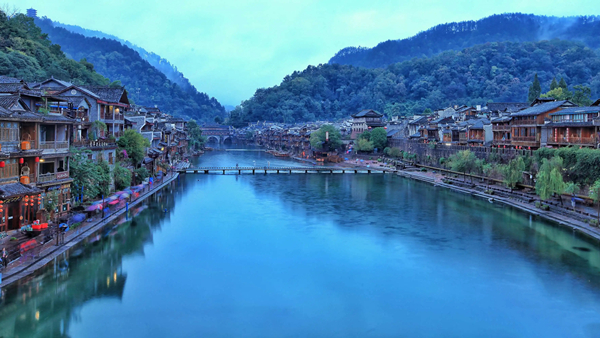Home> 湖南省文化和旅游厅>Tourism in Regions>Xiangxi>City Overview
Xiangxi Tujia and Miao Autonomous Prefecture
2022-05-25
Xiangxi Tujia and Miao Autonomous Prefecture is located on the border of Hunan Province, Hubei Province, Chongqing Municipality and Guizhou Province. It governs 115 townships (streets), seven counties and one city. Covering an area of 15,500 square kilometers, it has a total population of 2.948 million, of which 80.5% are ethnic minorities dominated by Tujia and Miao.

Xiangxi is an ecological autonomous prefecture. With its air and water quality ranking first in Hunan Province, it is the first choice for the development of green food and tourism.
Xiangxi is an autonomous prefecture with abundant culture and tourist resources. It has 1,517 places of historic and cultural interest, 172 traditional villages, 28 national intangible cultural heritage protection lists and 321 national eco-cultural tourism brands, including one world cultural heritage, one world geopark, one historical and cultural city, four historical and cultural towns.
Xiangxi is an autonomous prefecture with characteristic industries. It has formed a new industrial system based on modern agriculture, led by eco-cultural tourism and such emerging industries as electronic information and new materials, and supported by modern manufacturing and labor-intensive processing industry. It has tasty golden tea and fragrant Jiugui liquor. New materials are exported to the world, new industries are emerging, and cultural and creative products are going abroad. Two national modern agricultural industrial parks and nine provincial industrial parks have been built in Xiangxi.

Xiangxi is a leading autonomous prefecture in implementing targeted poverty alleviation. In recent years, Xiangxi has taken measures to fight against poverty and won an unprecedented victory in getting eight counties and cities, 1,110 poor villages and 656,000 people out of poverty. Taking Shibadong Village as a model, it has explored an effective way of targeted poverty alleviation that can be replicated and popularized, and created a “Xiangxi sample” for this initiative.
Xiangxi is an ecological autonomous prefecture. With its air and water quality ranking first in Hunan Province, it is the first choice for the development of green food and tourism.
With the stable forest coverage rate at more than 70%, it is a national key ecological functional area, national forest city, important ecological barrier of the Yangtze River Economic Belt. It has become one of the greenest areas in China, known as a model city of green development in China. Xiangxi has now built the world’s largest selenium-enriched Kiwi fruit base as well as China’s largest Ponkan and Lilium base. Xiangxi is the hometown of China’s golden tea and national high-quality tobacco, and its green, ecological, selenium-enriched organic agricultural products are quite famous at home and abroad.
Xiangxi is an autonomous prefecture with abundant culture and tourist resources. It has 1,517 places of historic and cultural interest, 172 traditional villages, 28 national intangible cultural heritage protection lists and 321 national eco-cultural tourism brands, including one world cultural heritage, one world geopark, one historical and cultural city, four historical and cultural towns.
Among them, the ancient town of Fenghuang, Laosicheng Site and ancient city of Liye enjoy a great reputation at home and abroad, and Aizhai-Shibadong Village-Dehang Canyon Scenic Spot is a national 5A tourist attraction. As a model area for the development of its culture and tourism, Xiangxi is one of the top ten tourism hot spots in China.
Xiangxi is an autonomous prefecture with characteristic industries. It has formed a new industrial system based on modern agriculture, led by eco-cultural tourism and such emerging industries as electronic information and new materials, and supported by modern manufacturing and labor-intensive processing industry. It has tasty golden tea and fragrant Jiugui liquor. New materials are exported to the world, new industries are emerging, and cultural and creative products are going abroad. Two national modern agricultural industrial parks and nine provincial industrial parks have been built in Xiangxi.


